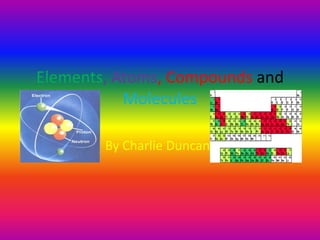
Chemical Reactions CD
- 1. Elements, Atoms, Compounds and Molecules By CharlieDuncan
- 2. Atoms An atom itself is made up of three tiny kinds of particles called subatomic particles: protons, neutrons, and electrons. The protons and the neutrons make up the center of the atom called the nucleus and the electrons fly around above the nucleus in a small cloud. The electrons carry a negative charge and the protons carry a positive charge. In a normal (neutral) atom the number of protons and the number of electrons are equal. Often, but not always, the number of neutrons is the same, too.
- 3. Elements An element is a substance that is made entirely from one type of atom. For example, the element hydrogen is made from atoms containing a single proton and a single electron. If you change the number of protons an atom has, you change the type of element it is.
- 4. Non-metals Metals Usually have 4-8 electrons in their outer shell. Gain or share valence electrons easily. Form oxides that are acidic. Are good oxidizing agents. Have higher electronegativities. *Usually have 1-3 electrons in their outer shell. *Lose their valence electrons easily. *Form oxides that are basic. *Are good reducing agents. *Have lower electronegativities.
- 5. Compounds A chemical compound is a pure chemical substance consisting of two or more different chemical elements that can be separated into simpler substances by chemical reactions. Chemical compounds have a unique and defined chemical structure. They consist of a fixed ratio of atomsthat are held together in a defined spatial arrangement by chemical bonds.
- 6. Chemical reactions A chemical reaction is a process that leads to the transformation of one set of chemical substances to another. They are studied by chemists under a field of science called chemistry. It can be either spontaneous that is requiring no input of energy or non-spontaneous, that often comes about only after input of some form of energy, viz. heat, light or electricity. Classically, chemical reactions encompass changes that strictly involve the motion of electrons in the forming and breaking of chemical bonds, although the general concept of a chemical reaction, in particular the notion of a chemical equation, is applicable to transformations of elementary particles, as well as nuclear reactions. The substance or substances initially involved in a chemical reaction are called reactants. Chemical reactions are usually characterized by a chemical change, and they yield one or more products, which usually have properties different from the reactants. Different chemical reactions are used in combination in chemical synthesis in order to get a desired product. In biochemistry, series of chemical reactions catalyzedby enzymes form metabolic pathways, by which syntheses and decompositions ordinarily impossible in conditions within a cell are performed.
- 7. Identifying chemical reactions If liquid water is boiled, it is still water, like frozen water, or ice, is it still water?. Melting, boiling, or freezing simply by the application of a change in temperature are examples of physical changes, because they do not affect the internal composition of the item or items involved. A chemical change, on the other hand, occurs when the actual composition changes that is, when one substance is transformed into another. Water can be chemically changed, for instance, when an electric current is run through a sample, separating it into oxygen and hydrogen gas.
- 8. Chemical reactions In a chemical change, bonds are broken and new bonds are formed between different atoms. This breaking and forming of bonds takes place when particles of the original materials collide with one another. Some exothermic reactions may be hot enough to cause certain chemicals to also undergo a change in state; for example in the case of aqueous solutions, bubbles may not necessarily be newly produced gas but instead water vapor. Physical reactions Physical change is a concept introduced to contrast with the concept of chemical change. A physical change is any change not involving a change in the substance's chemical identity. Matter undergoes chemical change when the composition of the substances changes: one or more substances combine or break up (as in a relationship) to form new substances. Physical changes occur when objects undergo a change that does not change their chemical nature. A physical change involves a change in physical properties. Physical properties can be observed without changing the type of matter. Examples of physical properties include: texture, shape, size, color, odor, volume, mass, weight, and density.
- 9. The reaction rate The reaction rate or rate of reaction for a reactant or product in a particular reaction is intuitively defined as how fast a reaction takes place. For example, the oxidation of iron under the atmosphere is a slow reaction which can take many years, but the combustion of butane in a fire is a reaction that takes place in fractions of a second.